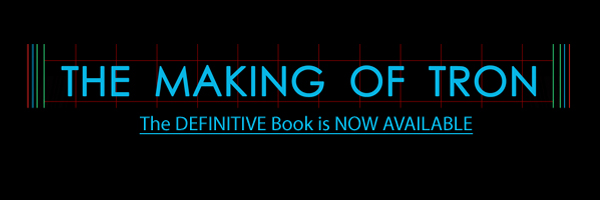THE SCREENING ROOM
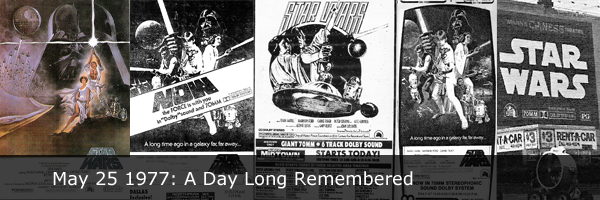
By Michael Coate
The date May 25, 1977 is immortalized forever as the “birthdate” of one
of the most popular movies ever made: “Star Wars.” Can you think
of any other movie whose release date is so well known?
In the 27 years since its release, “Star Wars” has gone from a modest
launch in a couple dozen theatres, to winning seven Academy Awards, to
selling hundreds of millions of
dollars of tie-in merchandise, to
influencing a generation of storytellers, and, according to Lucasfilm
Ltd. Vice President of Marketing Jim Ward, to selling over 100 million
home video units. The movie also positively influenced the
personal budget of George Lucas and
young stars like Harrison Ford, making them millionaires. Add to this, millions of DVDs recently welcomed
into many a home theatre library.
While audiences can now enjoy the movie on DVD, writer-director George
Lucas’ ongoing revisions have left a lot of fans feeling as though
there's a disturbance in the Force. Whether one approves or
disapproves of the changes made to the movie for the 1997 Special
Edition and the 2004 DVD version, what many do not realize is that
changes, no matter how subtle, have been made to “Star Wars” dating back
to its initial 1977 release. These include alternate sound mixes,
a revised opening scroll, and, possibly, some deleted scenes.
These adjustments, as well as the initial theatrical engagements, are
the subject of this article.
A Long Time Ago In A Theatre Far, Far Away....
For over two and a half decades, enthusiastic fans have related tales of
standing in long lines and recalling in astounding detail their first
impression of seeing the original movie in George Lucas’ legendary “Star
Wars” saga. Many moviegoers remember seeing the
movie on opening
day. Ah, but which opening day?The passage of time has caused
many people to forget that “Star Wars” (known today as “Star Wars:
Episode IV – A New Hope”) did not have the type of opening movies of
today enjoy: thousands of theatres simultaneously opening a film.
Rather, “Star Wars” opened initially in a mere 43 locations across the
United States.
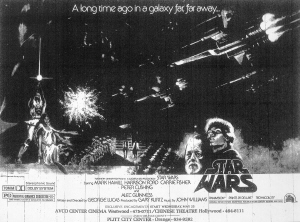
Southern California newspaper ad, May 15, 1977
Many sources over the years have cited 32 as the opening number of
engagements, and many trivia-minded fans may recognize the number.
The number 32 is correct... sort of. The film indeed opened with
32 engagements on the 25th of May, a mid-week Wednesday opening.
But what many may not realize is that additional bookings began on the
26th and 27th of May, which brought the opening weekend
engagement total
to 43. To say “Star Wars” opened in 32 theatres is literally
correct but does not tell the complete story.
The Original Engagements
So, who remembers the theatres in which “Star Wars” opened? For
the purpose of history and to provide a dose of trivia for the Jedi
Knights out there, what follows is the definitive list of original,
first-week engagements of “Star Wars.” (Fans may be interested in
knowing the list is more comprehensive than a similar listing posted on
the starwars.com website and the list provided to the press at the
junkets promoting the “Star Wars Trilogy” DVD release.)
Presentation Legend
* 70mm Dolby Stereo (magnetic)
** 35mm Dolby Stereo (optical)
*** 35mm mono (optical Dolby Stereo print)
Opened Wednesday, May 25, 1977:
ARIZONA
Phoenix: [Plitt] Ciné Capri ***
CALIFORNIA
Hollywood (Los Angeles): [Mann] Chinese *
Orange: [Plitt] City Center *
Sacramento: [Syufy] Century 25 ***
San Diego: [Mann] Valley Circle ***
San Francisco: [UA] Coronet *
San Jose: [Syufy] Century 22 ***
Westwood (Los Angeles): [GCC] Avco Center *
COLORADO
Denver: [Cooper Highland] Cooper **
DELAWARE
Claymont (Philadelphia, PA): [Sameric] Eric Twin Tri-State Mall ***
DISTRICT OF COLUMBIA
Washington: [RKO/Stanley-Warner] Uptown **
ILLINOIS
Milan (Quad-City, IA/IL): [Redstone] Showcase **
INDIANA
Indianapolis: [Y&W] Eastwood **
KENTUCKY
Louisville: [Redstone] Showcase **
MASSACHUSETTS
Boston: [Sack] Charles **
MICHIGAN
Southfield (Detroit): [Nicholas George] Americana Complex **
MINNESOTA
Roseville (St. Paul): [Northwest] Roseville 4 **
St. Louis Park (Minneapolis): [GCC] St. Louis Park ***
NEW JERSEY
Edison (New York, NY): [GCC] Menlo Park ***
Lawrenceville (Philadelphia, PA): [Sameric] Eric Twin Lawrenceville ***
Paramus (New York, NY): [RKO/Stanley-Warner] Triplex Paramus *
Pennsauken (Philadelphia, PA): [Sameric] Eric Twin Pennsauken ***
NEW YORK
Hicksville (Long Island): [Mann] Twin South *
Manhattan (New York): [Loews] Astor Plaza *
Manhattan (New York) [Loews] Orpheum *
OHIO
Springdale (Cincinnati): [Redstone] Showcase **
OREGON
Beaverton (Portland): [Luxury] Westgate **
PENNSYLVANIA
Fairless Hills (Philadelphia): [Sameric] Eric Twin Fairless Hills ***
Monroeville (Pittsburgh): [Redstone] Showcase East **
Philadelphia: [Sameric] Eric's Place ***
UTAH
Salt Lake City: [Plitt] Centre ***
WASHINGTON
Seattle: [UA] Cinema 150 **
Opened Thursday, May 26, 1977:
KANSAS
Overland Park (Kansas City, MO): [Dickinson] Glenwood **
Opened Friday, May 27, 1977:
ILLINOIS
Calumet City (Chicago): [Plitt] River Oaks ***
Chicago: [Plitt] Esquire **
Lombard (Chicago): [GCC] Yorktown ***
Northbrook (Chicago): [Lubliner & Sterns] Edens **
IOWA
Des Moines: [Dubinsky] River Hills **
MISSOURI
Creve Coeur (St Louis): [Wehrenberg] Creve Coeur **
NEBRASKA
Omaha: [Douglas] Cinema Center **
OHIO
Dayton: [Chakeres] Dayton Mall **
TEXAS
Dallas: [GCC] Northpark I&II ***
Houston: [GCC] Galleria ***
An immediate sensation, “Star Wars” accumulated incredible per-screen
averages and broke numerous box office and attendance records at the few
locations lucky enough to have been playing the movie. The film
industry was in shock, and exhibitors everywhere couldn't wait to get
their hands on a print. The film’s distributor, 20th Century-Fox,
quickly added one extra engagement in each of the Los Angeles, New York,
and Cincinnati markets, as well as starting two engagements in Honolulu.
Fox had the lab cranking out prints as fast as they could as they
accelerated their plans for a broad, nationwide release.
The expanded release began with over 100 new engagements added
throughout the U.S. during the week beginning June 15, with additional
engagements added each week throughout the summer. At its peak in
August and September of 1977, “Star Wars” was playing in approximately
1,100 theatres in the United States and Canada, and was well on its way
to surpassing “Jaws” (1975) and becoming the new all-time box office
champ. In the fall of ’77, “Star Wars” began its engagements in
foreign countries under such titles as "Guerre Stellari," "Krieg Der
Sterne," and "La Guerra De Las Galaxias."
Why So Few Theatres?
Why was “Star Wars” released initially to so few theatres when, in
retrospect, the movie seemed like such a sure-fire hit?
“No one knew it was going to be a big hit,” remembers Ben Burtt, who was
responsible for Special Dialogue & Sound Effects on “Star Wars.”
“Nowadays, we take for granted that a big blockbuster will go out with
thousands of prints... and open in May. But back then the summer
special effects blockbuster did not exist.”
In the 1997 book “Empire Building: The Remarkable Real Life Story Of
Star Wars,” former Fox executive Gareth Wigan offered an explanation: “
‘Star Wars’ only opened in forty theaters because we could only get
forty theaters to book it. That's the astonishing thing.”
Although there were certainly fewer movie theatres in operation during
the 1970s compared with today, a wide release of a mainstream,
non-specialized film at that time typically meant a few hundred
engagements. To illustrate just how low the number of theatres was
in which “Star Wars” opened, even by 1977 standards, here is for
comparison a sample of some of the highly-anticipated films from the
spring and summer of 1977 followed by the opening-week number of
engagements.
The Spy Who Loved Me (200+)
Smokey And The Bandit (300+)
A Bridge Too Far (400+)
New York, New York (400+)
Rollercoaster (400+)
The Other Side Of Midnight (500+)
Exorcist II: The Heretic (700+)
Orca (700+)
The Deep (800+)
In “The Unauthorized Star Wars Compendium” (1999), Charles Lippincott,
former Lucasfilm Ltd. Vice President for Advertising, Publicity,
Promotion and Merchandising, mentioned that “If the film was redone
today, on the basis of the way movies are released with a couple of
thousand prints, it probably would have been unsuccessful.
Theaters didn't want the movie. We were lucky to get thirty
theaters to open it.” Lippincott also remarked on the importance
and prestige of getting booked in a major Hollywood theatre and the
difficulty Fox faced in finding such a venue for “Star Wars.” “At
that time, Hollywood Boulevard was still very important for opening
films. We only got on Hollywood Boulevard because the new Billy
Friedkin film [‘Sorcerer’] wasn't ready yet. It was supposed to be
ready by May 25 but wasn't, and we were given a month in the Chinese.
It was the only way we got into Grauman's.”
In contrast with the belief shared by many that “Star Wars” was a tough
sell to exhibitors, at least a few people at 20th Century-Fox had a
hunch the movie could be a hit if marketed carefully and given a
prestige-style platform release, specifically keeping the number of
engagements limited to key markets during the initial weeks of release.
(Films during 1977 given successful platform releases included “Julia,”
“The Turning Point,” and “Close Encounters Of The Third Kind.”)
Peter Myers, Vice President of Domestic Distribution for Fox at the
time, first saw “Star Wars” in a test screening three months before
scheduled release. He was very impressed, and contemplated the
best approach to marketing the film. “The answer,” Myers revealed
to the Associated Press shortly following the movie's opening, “was to
position the picture in the proper theaters and give it the proper
presentation so the people themselves could discover it and spread the
word.”
Being Blown Off The Screen
For the Hollywood exposé “Easy Riders, Raging Bulls: How The
Sex-Drugs-And-Rock 'N' Roll Generation Saved Hollywood” (1998), film
editor Bud Smith recalled his experience in seeing the coming
attractions trailer he had cut for “Sorcerer” in front of “Star Wars” at
the Chinese Theatre: “When our trailer faded to black, the curtains
closed and opened again, and they kept opening and opening, and you
started feeling this huge thing coming over your shoulder overwhelming
you, and heard this noise, and you went right off into space. It
made our film look like this little, amateurish piece of shit. I
told Billy [Friedkin], ‘We're fucking being blown off the screen.
You gotta go see this.’ ”
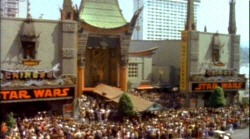
Mann's Chinese Theatre, 1977
To accommodate the opening of “Sorcerer” on June 24, 1977, the Hollywood
engagement of “Star Wars” was moved to another theatre a couple of
blocks down the street from the Chinese. Ultimately, the space
opera would have the last laugh. As “Sorcerer” failed to live up
to expectations while “Star Wars” continued to perform in stellar
fashion, Lucas’ epic moved back to the famous Chinese beginning August
3, where it stayed until June 1978. This marked the first time a
film had returned to the Chinese for a second first-run engagement in
the theatre's then fifty-year history. (The return of “Star Wars”
to the Chinese was highlighted by the foot and droid print ceremony in
the theatre's courtyard, an event thousands showed up to witness.)
Deleted Scenes – “I Saw That Scene!” “No, You Didn't.”
“Yes, I did!”
A controversy “Star Wars” has generated over the years is whether or not
any scenes were added to or deleted from the film after the initial
batch of prints were released to theatres. Many fans insist
changes were made, all of which Lucasfilm representatives have denied in
print and at many science-fiction and comic book conventions. Fan
recollections vary wildly and range from additional scenes featuring
Luke Skywalker and friend Biggs Darklighter, to an encounter with Jabba
the Hutt, to a brief bit with Chewbacca not scaring off the Death Star's
Mouse Robot, to a single shot of Luke throwing his grappling hook and
missing before throwing a second time successfully so he and Princess
Leia could swing across the Death Star chasm.
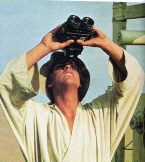
Deleted scene - Luke observing battle in space
While there is no doubt that the Jabba the Hutt scene and three scenes
set on Tatooine early in the movie featuring Luke (two of which included
Biggs) were deleted before the release, “The Unauthorized Star Wars
Compendium” includes a claim that the Luke-Biggs reunion scene in the
Rebel Hanger appeared in the original 1977 prints, only to be deleted
for the 1979 re-release, then re-instated for the 1997 Special Edition.
(The author of “The Unauthorized Star Wars Compendium” declined to be
interviewed for this article.)
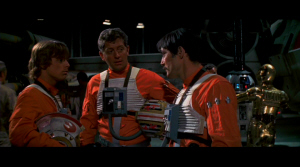
Deleted scene - Luke reunited with Biggs
Memory can be a strange thing, and while it has been difficult to
confirm changes made to the film, an explanation for fans’ recollections
of seeing things can be traced to the movie's assortment of tie-in
publications and merchandise. For example, the Ballantine novel,
the Marvel comic book adaptation, the Topps bubblegum card series, the
documentary “The Making Of Star Wars,” and the books “The Star Wars
Storybook” and “The Art Of Star Wars” all featured text, photos,
footage, or cartoon renditions of scenes scripted and/or shot. Combined
with the lack of availability of a (legal) version of “Star Wars” on
home video formats until five years following the original theatrical
release, one can see how anyone with a vivid imagination can convince
themselves that they saw footage that may have never appeared in a
theatrical presentation of the movie.
Episode What?!
Despite the deleted scenes conflict, one thing is certain: the “Episode
IV: A New Hope” tag at the head of the opening scroll was not present in
the original prints of the film. The tag was seen for the first
time by audiences in America during the spring 1981 re-release, the
first re-release after the 1980 original release of the follow-up to
“Star Wars”: “The Empire Strikes Back.”
.jpg)
In a May 1980 interview with The Seattle Times, George Lucas explained
why “Star Wars” was originally released without an episode number or
subtitle: “I chickened out at the last minute thinking people aren't
going to understand what this is all about, so we dropped ‘Episode IV: A
New Hope.’ Now we're putting it back on. ‘Empire’ will be
called ‘Episode V.’ ”
.jpg)
The presence of an episode number and subtitle on the opening scroll of
“The Empire Strikes Back” caused some confusion and received coverage in
many film reviews and major news and film industry magazines, including
TIME, Newsweek, and American Cinematographer. Why the confusion?
Obviously, audiences had not yet seen a “Star Wars” movie begin with an
episode number or subtitle!
The “Empire” film review that appeared in The Washington Post clarified
the situation: “When ‘Star Wars’ is reissued, probably next summer, the
prints will include the subtitle, ‘Episode IV: A New Hope.’ This
adjustment may already be seen in the published screenplay, which came
out last winter in an attractive book called ‘The Art Of Star Wars.’ ”
Dolby Jumps To Hyperspace
The engrossing “Empire Of Dreams” documentary included on the “Star Wars
Trilogy” DVD bonus disc offers a portrait of George Lucas as a maverick,
independent filmmaker, and covers the production, release, and afterlife
of “Star Wars.” While the opening of the movie initially in only a
handful of theatres is represented, curiously, the documentary fails to
explore in detail the influence the film had on production and
exhibition technology, namely the use of and eventual industry-wide
adoption of Dolby Stereo sound. “Star Wars,” it can be argued, has
influenced the motion picture industry and a generation of moviegoers
more so than any other single motion picture.
Perhaps the lack of coverage in “Empire Of Dreams” is due to the
filmmakers’ desire to avoid addressing the controversy and confusion
that has existed regarding the presentation type audiences experienced
in the opening weeks of release. Numerous books, articles and fan
recollections have attributed “Star Wars” as having an exclusive opening
in the Dolby Stereo process (Dolby System, as it was then known).
Other claims have included “Star Wars” being the first film ever
released in Dolby Stereo, or that all of the initial prints of the film
were in the 70-millimeter wide gauge format. None of the claims
are correct, though by extensively researching the subject it becomes
clear how one could be misled.
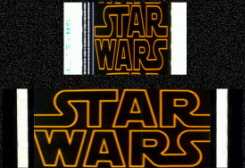
Above: 35mm Frame From "Star Wars" With
Optical Soundtrack – Below: 70mm Frame With Magnetic Soundtrack
“Star Wars” was indeed released in Dolby Stereo, but was not the first
film to utilize the then-fledgling technology. A few films prior
to “Star Wars” were released in various forms of Dolby Stereo on a
limited or test engagement basis. Examples include “Tommy” (1975),
“Nashville” (1975), “Lisztomania” (1975), “Logan's Run” (1976), and “A
Star Is Born” (1976). “Star Wars” was the first attempt at a wide
release in the Dolby Stereo format in the sense that all of the prints
put into circulation in the initial wave were Dolby-encoded. All
of the prints, however, were not necessarily decoded during playback
using Dolby equipment; in other words, the initial mono presentations
were Dolby prints played in mono. It appears that the distributor
sought to book “Star Wars,” at the filmmakers’ urging, in as many
theatres as possible willing to install Dolby sound systems. The
number of suitably-equipped venues, however, fell short of the total
number of prints initially put into circulation. As for release
prints in the deluxe (and expensive) 70mm format – with its superior
projection quality and exquisite six-track magnetic audio – they were
kept to a minimum.
But I Swear I Saw ‘Star Wars’ In 70mm
Many technology-savvy and quality-conscious moviegoers may have a
distinct recollection of attending a 70mm (blow-up) presentation of
“Star Wars.” However, in looking over the list of original
engagements some may be surprised to find that only eight 70mm
engagements are noted, and that they were limited to theatres in the Los
Angeles, New York, and San Francisco markets. Ah, but some of you
are positive you saw a 70mm showing at a big, famous theatre in
Washington, D.C., or Dallas, or Chicago, or Detroit, or even Honolulu.
Well, you did... but not during the film's opening weekend!
Throughout the summer and fall of 1977, as “Star Wars” continued to
perform beyond expectations, Fox ordered several new 70mm prints, and
many theatres were provided with a large-format print. By
Christmas 1977,
over two dozen 70mm engagements were playing throughout major cities in
the U.S.
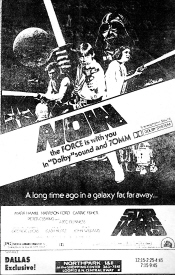
Newspaper ad in Dallas
When people fondly recall the soundtrack experience of “Star Wars” – the
rumble of the Imperial Cruiser in the classic opening scene... the
squeaks and chirps of R2-D2... the hum of the lightsabers... the roar of
the TIE Fighters... the Millennium Falcon's escape from the Mos Eisley
spaceport and jump to hyperspace... the unforgettable John Williams
music score... the climactic explosion of the Death Star... – it is
likely that one's memory is based upon having attended a 70mm Six-Track
Dolby Stereo presentation, with its easily apparent superiority over
conventional 35mm stereo and monaural presentations. While all
things “digital” are commonplace today, back then 70mm was the
Rolls-Royce of the movies.
As a result of the impact of “Star Wars,” the number of theatres
equipped for stereo sound increased significantly, as did the number of
films being mixed for stereo playback. Counting those initial
theatres that installed Dolby for their “Star Wars” engagement, the
number of Dolby-equipped theatres in the world by the end of May 1977
was fewer than 50. By the following year, when the film was
retired from release, the number of equipped venues topped 700. As
for films available with Dolby-encoded soundtracks, the number doubled
in 1978 compared with the previous year and would continue to increase
each year. As well, the 70mm format, which thrived during the
1950s and ’60s, enjoyed a renaissance of sorts with many event movies
being released in the magnetic six-track format on 70mm prints for
selected theatres as well as in optical Dolby on conventional 35mm
prints compatible in all movie theatres throughout the world.
Now You Hear It, Now You Don't
Variations in the soundtrack presentations of “Star Wars” can be traced
to the multiple mixes that were prepared to accommodate the different
formats in which the movie would be released:
1) 35mm stereo (optical, two-track/four-channel)
2) 35mm stereo (magnetic, four-track)
3) 70mm stereo (magnetic, six-track)
4) 35mm mono (optical)
The sound editing and re-recording team began by preparing a four-track
master mix (Left-Center-Right-Surround) which would serve as the basis
for both the 35mm and 70mm stereo versions. First, the master mix
was dubbed to a matrix-encoded two-track Lt-Rt (Left total-Right total)
printmaster for use in creating the 35mm Dolby Stereo prints. Then, the
same four-track master, with some enhancements added, was used to create
the six-track version. In comparison to the 35mm Dolby Stereo
version, the Six-Track Dolby Stereo version during playback offered
discrete channels, greater clarity, superior dynamic range, and two
extra channels for special low-frequency enhancement, in what the Dolby
folks affectionately called “baby boom.” After completing the
multichannel versions, the soundtrack crew created another
English-language mix: a monaural mix. This would be included on
prints destined for theatres not equipped with a stereophonic sound
system and for versions prepared for ancillary markets. The mono
prints were put into circulation upon the wide national break in June
1977.
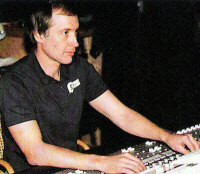
Sound designer Ben Burtt
Although the 35mm Dolby Stereo process is mono-compatible, at the time
those involved with the new technology were, for both technical and
aesthetic reasons, concerned about the effectiveness of mono playback
from a stereo-encoded print. For similar reasons, a decision was
made not to create the mono master by means of dubbing the stereo master
and folding the multiple tracks into one. Instead, a new dedicated
mono mix was created.
With each subsequent mix, the filmmakers seized opportunities to revise
and enhance selected portions of the soundtrack where they had felt
rushed or shortchanged creatively. Sound Designer Ben Burtt
recalls: “Because we were always trying to make the film better and
better and fix things that were not right, there were some sweetener
tracks added; things like different C-3PO or Stormtrooper lines [‘Close
the blast doors’], additional sound effects, or some different ADR [the
dialogue of Aunt Beru].” Knowing that multiple mixes were made
containing subtle yet detectable differences help explain conflicting
memories of moviegoers who remember hearing a certain sound effect or
line of dialogue in one presentation but not in another.
It may be difficult to comprehend today as most major film releases on
DVD sport a 5.1-channel digital soundtrack, but at the time, not knowing
what the future would hold in terms of widespread adoption of
multichannel sound in movie theatres and in homes, some members of the
production felt the mono mix represented the definitive soundtrack of
“Star Wars.” They felt that the stereo version was a novelty that
selected audiences would be treated to only during a brief theatrical
run. “George put a lot of effort in that mono mix,” Burtt
remembers. “And he even said several times, ‘Well, this is the
real mix. This is the definitive mix of the film.’ He paid
more attention to it because he felt it was more important archivally.”
Conclusion
No matter how often George Lucas waves his magic wand and makes changes
to “Star Wars,” for many, the memory of experiencing the magical
space-fantasy in 1977 will never fade. Perhaps this explains the
enduring appeal of the movie, despite the ongoing revisions made to it.
This article was written to preserve those memories and to provide a
history of the original release of the movie. Obi-Wan Kenobi was
right: The Force will be with [us]...always.
